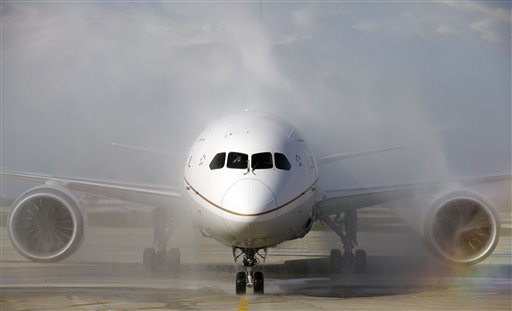
In this Nov. 4, 2012, file photo, a United Airlines 787 Dreamliner arrives at O’Hare international Airport in Chicago, from Houston, after making United’s inaugural 787 revenue flight. Airline passenger numbers are set to rise by over a quarter in the coming years to hit 3.6 billion in 2016, with China accounting for nearly one in four new travelers, the International Air Transport Association (IATA) said Thursday, Nov. 6, 2012. AP PHOTO/NAM Y. HUH
GENEVA—Airline passenger numbers are set to rise by over a quarter in the coming years to hit 3.6 billion in 2016, with China accounting for nearly one in four new travelers, the International Air Transport Association (IATA) announced Thursday.
The Geneva-based organization said that the 28.5-percent global increase over the next five years means that airlines will carry 831 million more people in 2016 than in 2011.
“Despite the current economic uncertainty, expected demand for connectivity remains strong,” said Tony Tyler, director general of IATA, which said that aviation supports 57 million jobs and $2.2 trillion (1.68 trillion euros) in economic activity.
Almost 500 million new passengers are expected to travel on domestic routes and 331 million will take international routes, IATA said in its Airline Industry Forecast 2012-2016.
And while the United States is to remain the largest air travel market over the five-year period – with 710 million domestic passengers and 223 million international travelers by 2016 – its growth rates “will be well below” the global average of 5.3 percent for international travel and 5.2 percent for domestic routes, IATA said.
By contrast, the emerging economies of Asia-Pacific, Latin America and the Middle East will see the strongest passenger growth, the report showed, with routes within or connected to China accounting for 193 million of the 831 million new passengers by 2016.
By 2016, IATA continued, the Asia-Pacific region will represent 33 percent of global passengers, up from 29 percent in 2011 and ahead of North America and Europe, forecast to represent 21 percent.
IATA, which speaks for 240 airlines comprising 84 percent of global air traffic, forecast that freight growth will expand at 3.0 percent annually, from 29.6 million tons in 2011 to 34.5 million tons in 2016.
Tyler described the increased passenger numbers as “good news for the global economy” since growing air transport links “generate jobs and underpin economic growth in all economies.”
But the IATA chief warned governments “to recognize aviation’s value with policies that do not stifle innovation, tax regimes that do not punish success and investments to enable infrastructure to keep up with growth.”